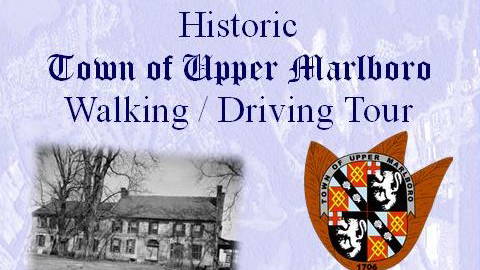About Walking Tour KS
Settled around 1695 and named after the first Duke of Marlborough, the Town of Upper Marlboro is among the oldest of the surviving Southern Maryland towns dating back to colonial times. It was established as a port town for tobacco shipments in 1706, when the Western Branch of the Patuxent River was still navigable. It has been the county seat of Prince George’s County since 1721.
It is the birthplace of John Carroll, the first Catholic Archbishop in the United States and founder of Georgetown College. His brother Daniel was a signer of the U.S. Constitution. Thomas John Claggett was the First Episcopal Bishop consecrated in the United States, the first bishop of the Episcopal Diocese of Maryland and organized the Trinity Church in Upper Marlboro in 1810.
Town resident John Rogers was one of three Maryland delegates to the Second Continental Congress, held in 1776. Daniel Carroll, a native of Upper Marlborough, participated in the deliberations of the Constitutional Convention.
In the early years of the eighteenth century, a tobacco port town known as Colonel Belt’s Landing developed on the Western Branch of the Patuxent river. Area planters would roll their hogsheads of tobacco down the rolling road and load them onto barges to be poled down to the deep water ocean vessels anchored at Jug Bay on the Patuxent. By 1706, the Maryland Assembly officially chose this site for a new town in Prince George’s County. Marlborough (named in honor of the hero of the Battle of Blenheim, the Duke of Marlborough,) was formed from 100 acres taken from the patented properties of several local planters.
In 1718, the population of this town and adjacent areas had grown at the expense of the County’s first town and County Seat Charles Town. The General Assembly decided to move the court proceedings to Marlborough in 1721 and since then this town has served as the County Seat of Prince George’s County. It soon became known as “Upper” Marlborough to distinguish it from “Lower” Marlborough down river on the Calvert side of the Patuxent. The spelling of Marlborough was gradually changed to Upper Marlboro without the “ugh”, possibly due to the actions of a postal clerk who consolidated the letters to fit on contemporary rubber stamps. In 1893 the U.S. Post Office began referring to the town as Upper Marlboro.
In the eighteenth century, Marlboro was the geographic and population center of the county. Throughout the eighteenth and nineteenth centuries, Marlboro retained its prominence as a political and cultural center. Disastrous fires over 3 centuries, as well as demolitions and relocations over the past 60 years, have robbed Upper Marlboro of a portion of its 18th and 19th century streetscapes and its some of its handsome architectural treasures. However, several notable historic structures remain and are the subject of this Tour.
